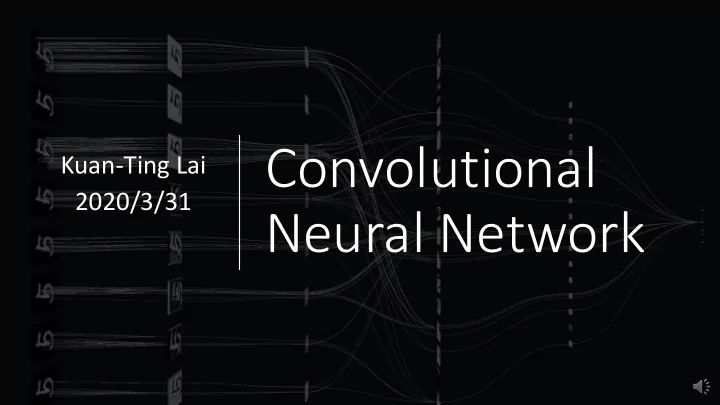

Convolutional Kuan-Ting Lai 2020/3/31 Neural Network
Convolutional Neural Networks (CNN) • A.k.a. CNN or ConvNet Adit Deshpande, A Beginner's Guide To Understanding Convolutional Neural Networks.
Digital Images • Input array: an image’s height × width × 3 (RGB) • Value of each pixel: 0 - 255
Classification, Localization, Detection, Segmentation
Convolution Theorem • Fourier transform of a convolution of two signals is the pointwise product of their Fourier transforms
2D Convolution: Sobel Filter https://en.wikipedia.org/wiki/Sobel_operator
Example: A Curve Filter
Scan the Image to Detect an Edge
Edge Detected!
Continue Scanning (No edge)
Spatial Hierarchy of Features
Create First ConvNet • Create a CNN to classify MNIST digits from keras import layers from keras import models model = models.Sequential() model.add(layers.Conv2D(32, (3, 3), activation='relu', input_shape=(28, 28, 1))) model.add(layers.MaxPooling2D((2, 2))) model.add(layers.Conv2D(64, (3, 3), activation='relu')) model.add(layers.MaxPooling2D((2, 2))) model.add(layers.Conv2D(64, (3, 3), activation='relu'))
Model Summary • model.summary() ________________________________________________________________ Layer (type) Output Shape Param # ================================================================ conv2d_1 (Conv2D) (None, 26, 26, 32) 320 ________________________________________________________________ maxpooling2d_1 (MaxPooling2D) (None, 13, 13, 32) 0 ________________________________________________________________ conv2d_2 (Conv2D) (None, 11, 11, 64) 18496 ________________________________________________________________ maxpooling2d_2 (MaxPooling2D) (None, 5, 5, 64) 0 ________________________________________________________________ conv2d_3 (Conv2D) (None, 3, 3, 64) 36928 ================================================================
Feature Map • Outputs of a Convolution Layer is also called as Feature Map =>layers.Conv2D(32, (3, 3), activation='relu', input_shape=(28, 28, 1)) − Receive a 28x28 input image and computes 32 filters over it − Each filter has size 3x3
Kernel and Filter in Deep Learning • “Kernel” refers to a 2D array of weights. • “filter” is for 3D structures of multiple kernels stacked together. https://towardsdatascience.com/a-comprehensive-introduction-to-different-types-of-convolutions-in-deep-learning-669281e58215
Add a Classifier on Top of ConvNet model.add(layers.Flatten()) model.add(layers.Dense(64, activation='relu')) model.add(layers.Dense(10, activation='softmax')) Layer (type) Output Shape Param # ================================================================= conv2d_1 (Conv2D) (None, 26, 26, 32) 320 _________________________________________________________________ max_pooling2d_1 (MaxPooling2 (None, 13, 13, 32) 0 _________________________________________________________________ conv2d_2 (Conv2D) (None, 11, 11, 64) 18496 _________________________________________________________________ max_pooling2d_2 (MaxPooling2 (None, 5, 5, 64) 0 _________________________________________________________________ conv2d_3 (Conv2D) (None, 3, 3, 64) 36928 _________________________________________________________________ flatten_1 (Flatten) (None, 576) 0 _________________________________________________________________ dense_1 (Dense) (None, 64) 36928 _________________________________________________________________ dense_2 (Dense) (None, 10) 650 ================================================================= Total params: 93,322 Trainable params: 93,322 Non-trainable params: 0
Padding • Padding a 5x5 input to extract 25 3x3 patches
Stride=1
Stride=2
Max Pooling • Downsampling an image • Better than average pooling and strides
Train a Model to Classify Cats & Dogs • www.kaggle.com/c/dogs-vs-cats/data • 2000 cat and 2000 dog images
Create a CNN Model for Binary Classification from keras import layers from keras import models model = models.Sequential() model.add(layers.Conv2D(32, (3, 3), activation='relu', input_shape=(150, 150, 3))) model.add(layers.MaxPooling2D((2, 2))) model.add(layers.Conv2D(64, (3, 3), activation='relu')) model.add(layers.MaxPooling2D((2, 2))) model.add(layers.Conv2D(128, (3, 3), activation='relu')) model.add(layers.MaxPooling2D((2, 2))) model.add(layers.Conv2D(128, (3, 3), activation='relu')) model.add(layers.MaxPooling2D((2, 2))) model.add(layers.Flatten()) model.add(layers.Dense(512, activation='relu')) model.add(layers.Dense(1, activation='sigmoid'))
Image Generator from keras.preprocessing.image import ImageDataGenerator train_datagen = ImageDataGenerator(rescale=1./255) 1. Read the picture files. test_datagen = ImageDataGenerator(rescale=1./255) 2. Decode the JPEG content to train_generator = RGB grids of pixels. train_datagen.flow_from_directory( train_dir, 3. Convert these into floating- target_size=(150, 150) point tensors. batch_size=20, class_mode='binary') 4. Rescale the pixel values validation_generator = test_datagen.flow_from_directory( (between 0 and 255) to the [0, validation_dir, 1] interval target_size=(150, 150), batch_size=20, class_mode='binary')
Python Generator • Use yield operator • Note that the generator loops endlessly
Fitting the Model using a Batch Generator history = model.fit_generator( train_generator, steps_per_epoch=100, epochs=30, validation_data=validation_generator, validation_steps=50) # Save the model model.save('cats_and_dogs_small_1.h5')
Data Augmentation
Data Augmentation via ImageDataGenerator • rotation_range is a value in degrees (0 – 180) • width_shift and height_shift are ranges (as a fraction of total width or height) within which to randomly translate pictures vertically or horizontally. • shear_range is for randomly applying shearing transformations. • zoom_range is for randomly zooming inside pictures. • horizontal_flip is for randomly flipping half the images horizontally • fill_mode is the strategy used for filling in newly created pixels, which can appear after a rotation or a width/height shift. datagen = ImageDataGenerator( rotation_range=40, width_shift_range=0.2, height_shift_range=0.2, shear_range=0.2, zoom_range=0.2, horizontal_flip=True, fill_mode='nearest')
Using Pre-trained Models • Xception • VGG16 • VGG19 • ResNet, ResNetV2, ResNeXt • InceptionV3 • InceptionResNetV2 • MobileNet • MobileNetV2 • DenseNet • NASNet
Example: Using Pre-trained VGG16 • weights specifies the weight checkpoint from which to initialize the model. • include_top refers to including (or not) the densely connected classifier on top of the network (1,000 classes output). • input_shape the network will be able to process inputs of any size it the argument is omitted. from keras.applications import VGG16 conv_base = VGG16(weights='imagenet', include_top=False, input_shape=(150, 150, 3))
Adding a Classifier on Top of a Pre-trained Model from keras import models from keras import layers model = models.Sequential() model.add(conv_base) model.add(layers.Flatten()) model.add(layers.Dense(256, activation='relu')) model.add(layers.Dense(1, activation='sigmoid')) Layer (type) Output Shape Param # ================================================================ vgg16 (Model) (None, 4, 4, 512) 14714688 ________________________________________________________________ flatten_1 (Flatten) (None, 8192) 0 ________________________________________________________________ dense_1 (Dense) (None, 256) 2097408 ________________________________________________________________ dense_2 (Dense) (None, 1) 257 ================================================================ Total params: 16,812,353 Trainable params: 16,812,353 Non-trainable params: 0
Freezing Trainable Parameters • conv_base.trainable = False
Fine-Tuning Top Few Layers • Freezing all layers up to a specific one conv_base.trainable = True set_trainable = False for layer in conv_base.layers: if layer.name == 'block5_conv1': set_trainable = True if set_trainable: layer.trainable = True else: layer.trainable = False
Summary • Convnets are the best for Computer Vision (and maybe all the other tasks) • Data augmentation is a powerful way to fight overfitting • We can use pre-trained model for feature extraction • We can further improve the pre-trained model on our dataset by fine-tuning
Visualizing What Convnets Learn 1. Visualizing Intermediate ConvNet Outputs (Intermediate Activations) − Understand how successive convnet layers transform their input − Get a first idea of the meaning of individual convnet filters 2. Visualizing ConvNets Filters − Understand precisely what visual pattern or concept each filter in a convnet is receptive to 3. Visualizing Heatmaps of Class Activation in an Image − See which parts of an image were identified as belonging to a given class − Can localize objects in images.
Recommend
More recommend